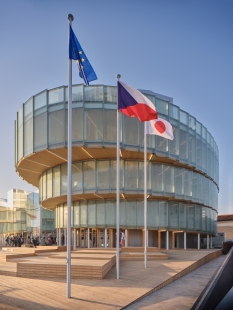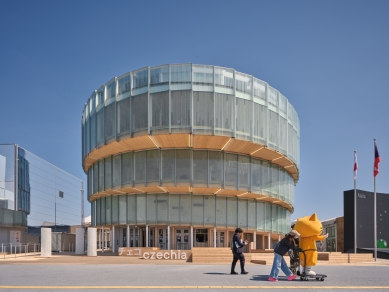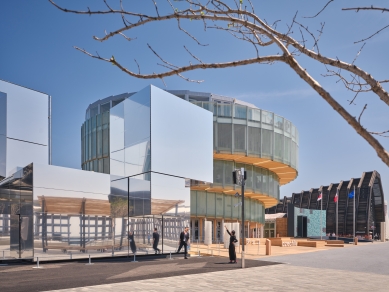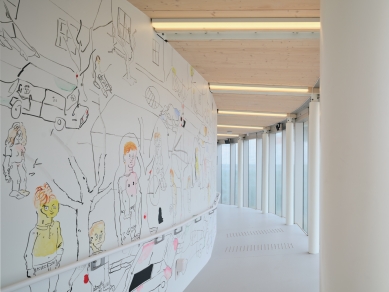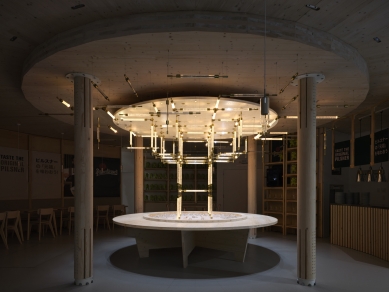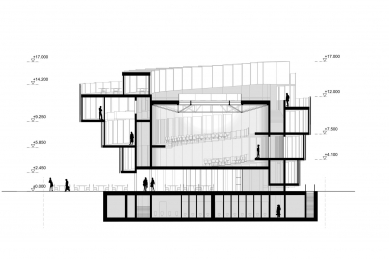
<Czech National Pavilion at EXPO 2025>

The architecture of the Czech national pavilion, which opened to the public on April 13 at the World Expo EXPO 2025 in Osaka, reflects the idea of life energy and continuous development. The design was created by Apropos Architects, who work with the motif of a spiral. Visitors to the pavilion walk along a 260-meter-long path that winds around the structure, gradually ascending through four floors before emerging on the observation roof. This dynamic movement symbolizes not only the passage of time and the development of the individual, but also personal and societal growth.
The World Expo EXPO 2025 returns to Osaka after 55 years, and Apropos Architects' transparent building with a glass spiral sensitively references the Czech pavilion in Japan from 1970.
The pavilion, located at a significant intersection of the coastal promenade and the main boulevard, is an architectural exhibit in itself. It captures attention with its silhouette, which expands upward and seemingly defies the force of gravity, and its transparent glass façade. This façade, made of plate artistic glass, not only references the rich tradition of Czech glassmaking but also creates a unique exhibition space. Thanks to the changing daylight, the atmosphere of the interior continuously transforms, adding dynamism and a unique visual experience to the exhibition.
As visitors move along the gallery path, they engage physically while absorbing the artistic content of the exhibition, which enhances their inner vitality. The pavilion's architecture encourages upward movement and physical activity, while the exhibition inspires mental contemplation. Together, they create a space that connects the movement of the body and the mind.
A unique multimedia installation inside the gallery path features renowned Czech visual artists. The exhibition begins with a monumental crystal sculpture, "Trees Grow into the Sky" by Rony Plesl. The main visual element is the drawn-painting narrative of Jakub Matuška aka Masker, which stretches around the entire pavilion. His composition, over 200 meters long, metaphorically spirals as a reflection of human effort. An impressive audiovisual experience is enhanced by the multimedia installation from Lunchmeat Studio, which connects the entire space. The path, linking historical heritage with innovative art, also includes the bronze sculpture "Nude on a Rock" by Alphonse Mucha and a fascinating glass installation "Herbarium" by Lasvit.
There are also architecturally interesting niches inside the tube. At the very top, twelve meters above the ground, a ramp leads to a spacious observation terrace. This ends with a prominent roof "crown," where the VIP Lounge is located. From here, visitors can enjoy not only the panorama of the calm sea but also a stunning view through the glass skylight directly down into the auditorium.
The final chapter of the exhibition and the metaphorical journey of visitors through the pavilion is the staircase from the observation area back down to the ground. It is set into the cavity of the double walls of the cylinder, leading to the ground floor with a restaurant where people can enjoy Czech cuisine. Next to the visitor staircase from the observation area to the ground floor, a second staircase runs through the inner tube, serving the auditorium. The staircases connect the tiers of the auditorium, the ground floor restaurant, and the VIP lounge. The clever composition of both staircases ensures a clear separation of the exhibition and the multifunctional hall's operations. Barrier-free access is provided by an elevator in the western part of the building.
The spiral visitor path encircles the central tube of the multifunctional hall - the auditorium. This space at the heart of the pavilion, with an internal diameter of 15.5 meters, rises 12 meters above the ground and will serve for cultural performances, lectures, and other programs. It is conceived as a so-called black box. The audience seating in the auditorium follows the outline of the visitor path, with the auditorium and gallery connected at several points. This allows these spaces to be variably separated or fluidly connected according to current needs.
The ceilings and exposed structures are left revealed in wood. The supporting structure consists of a system of cross-laminated spruce CLT panels, which form the central fulcrum of the auditorium with embedded staircases and an elevator. The core of the building is complemented by horizontally placed slabs. These help shape the exhibition spiral outward and the balconies of the multifunctional hall inward.
The building reaches a height of 16 meters and is planimetric divided into 36 segments. Individual segments define a circle in the lower floors, while in the upper floors, they smoothly transition into an ellipse that defines the envelope and mass of the pavilion. The space in front of the pavilion is designed as a wooden deck with boxes where visitors and passersby can comfortably sit and reflect.
The World Expo EXPO 2025 returns to Osaka after 55 years, and Apropos Architects' transparent building with a glass spiral sensitively references the Czech pavilion in Japan from 1970.
The pavilion, located at a significant intersection of the coastal promenade and the main boulevard, is an architectural exhibit in itself. It captures attention with its silhouette, which expands upward and seemingly defies the force of gravity, and its transparent glass façade. This façade, made of plate artistic glass, not only references the rich tradition of Czech glassmaking but also creates a unique exhibition space. Thanks to the changing daylight, the atmosphere of the interior continuously transforms, adding dynamism and a unique visual experience to the exhibition.
As visitors move along the gallery path, they engage physically while absorbing the artistic content of the exhibition, which enhances their inner vitality. The pavilion's architecture encourages upward movement and physical activity, while the exhibition inspires mental contemplation. Together, they create a space that connects the movement of the body and the mind.
A unique multimedia installation inside the gallery path features renowned Czech visual artists. The exhibition begins with a monumental crystal sculpture, "Trees Grow into the Sky" by Rony Plesl. The main visual element is the drawn-painting narrative of Jakub Matuška aka Masker, which stretches around the entire pavilion. His composition, over 200 meters long, metaphorically spirals as a reflection of human effort. An impressive audiovisual experience is enhanced by the multimedia installation from Lunchmeat Studio, which connects the entire space. The path, linking historical heritage with innovative art, also includes the bronze sculpture "Nude on a Rock" by Alphonse Mucha and a fascinating glass installation "Herbarium" by Lasvit.
There are also architecturally interesting niches inside the tube. At the very top, twelve meters above the ground, a ramp leads to a spacious observation terrace. This ends with a prominent roof "crown," where the VIP Lounge is located. From here, visitors can enjoy not only the panorama of the calm sea but also a stunning view through the glass skylight directly down into the auditorium.
The final chapter of the exhibition and the metaphorical journey of visitors through the pavilion is the staircase from the observation area back down to the ground. It is set into the cavity of the double walls of the cylinder, leading to the ground floor with a restaurant where people can enjoy Czech cuisine. Next to the visitor staircase from the observation area to the ground floor, a second staircase runs through the inner tube, serving the auditorium. The staircases connect the tiers of the auditorium, the ground floor restaurant, and the VIP lounge. The clever composition of both staircases ensures a clear separation of the exhibition and the multifunctional hall's operations. Barrier-free access is provided by an elevator in the western part of the building.
The spiral visitor path encircles the central tube of the multifunctional hall - the auditorium. This space at the heart of the pavilion, with an internal diameter of 15.5 meters, rises 12 meters above the ground and will serve for cultural performances, lectures, and other programs. It is conceived as a so-called black box. The audience seating in the auditorium follows the outline of the visitor path, with the auditorium and gallery connected at several points. This allows these spaces to be variably separated or fluidly connected according to current needs.
The ceilings and exposed structures are left revealed in wood. The supporting structure consists of a system of cross-laminated spruce CLT panels, which form the central fulcrum of the auditorium with embedded staircases and an elevator. The core of the building is complemented by horizontally placed slabs. These help shape the exhibition spiral outward and the balconies of the multifunctional hall inward.
The building reaches a height of 16 meters and is planimetric divided into 36 segments. Individual segments define a circle in the lower floors, while in the upper floors, they smoothly transition into an ellipse that defines the envelope and mass of the pavilion. The space in front of the pavilion is designed as a wooden deck with boxes where visitors and passersby can comfortably sit and reflect.
The English translation is powered by AI tool. Switch to Czech to view the original text source.
2 comments
add comment
Subject
Author
Date
Pavilon ČR
Doležel
14.04.25 01:36
Dojmy z Pavilonu
Martin Z.
15.04.25 05:39
show all comments




